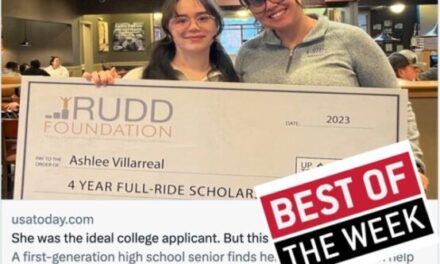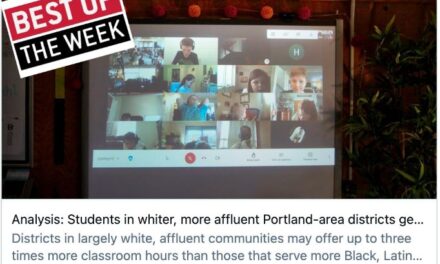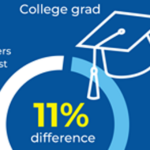The leading force behind ‘Sold a Story’ is helping launch a new, journalists-only listserv to help reporters get the literacy story right.
By Emily Hanford
At the EWA national conference in 2015, journalist Nikole Hannah-Jones stood in front of a large group of education reporters and said, “I write about school segregation because I must. Because we all must.”
I feel the same way about reading instruction.
There has been a noticeable increase in the amount of reporting on this topic.
Some of it is news driven. At least 22 states introduced new laws this year regarding reading instruction.
And plenty of people wrote about the September announcement out of Teachers College Columbia that its influential Reading and Writing Project, founded in 1981 by Professor Lucy Calkins, would be “dissolved” (though the university later walked back the term “dissolved”).
I’m glad this issue is getting more attention, but I’m concerned about some of the coverage.
I think past efforts to improve reading instruction were hindered in part because of how they were framed by reporters and editors.
Journalists can do better.
We have a responsibility to get this critical story right.
We have a responsibility to get this critical story right.
Previous columns in our literacy series: A low grade for literacy coverage (Susan B. Neuman), Don’t call it ‘the reading wars’ (Molly Ness), Inadequate literacy coverage in New York City (Lee Gaul), Bringing energy and creativity to literacy coverage (Alan J. Borsuk).
Let me start by saying that I think there has been some really good reporting.
Some examples include Rupen Fofaria’s stories out of North Carolina. Mandy McLaren’s investigation into why so many kids struggle in Kentucky. Alex Baumhardt’s special report on money wasted in Oregon. Education Week, in particular Sarah Schwartz, who has written in-depth pieces and consistently covered the news. Chalkbeat has done some great reporting too, especially in Colorado. And Troy Closson’s coverage of the events in New York City stands out.
Those examples and the other good reporting I have seen share three distinguishing characteristics: 1) the reporters talk to teachers 2) the reporters clearly understand key takeaways from the scientific research, and 3) they don’t reduce the story to phonics.
Those examples share three distinguishing characteristics.
When I started reporting on this topic six years ago, I knew nothing. I’d never thought much about how kids learn to read. I learned to read pretty easily. My kids did, too.
And I had no reporting history with literacy instruction. I didn’t cover the reading wars of the 1990s or the release of the National Reading Panel report or the controversy around Reading First.
I became an education reporter in 2008, just as the nation’s attention — and journalists’ attention — were beginning to turn away from elementary reading instruction.
So when I started hearing from parents all over the country that their kids weren’t learning how to read in school, I was perhaps naïve enough to just dig in. I hadn’t been burned out by the reading wars. I was curious. How do people learn to read? How are kids being taught?
I had no idea this reporting would have such a big impact. I started with some basic explanatory journalism. I read a ton (I put together a reading list here.) Talked to researchers. Visited schools. Interviewed teachers and parents and kids.
I knew I was on to a big story after “Hard Words” came out in 2018. The response was intense, from educators in particular. Some of them were angry. They were convinced I’d gotten the story wrong. But most of them were grateful. “I had no idea,” educators told me over and over again. “I had no idea how kids learned to read.”
I had no idea this reporting would have such a big impact.
Why didn’t teachers know? That’s the question that led to the “Sold a Story” podcast.
What I realized a couple of years into this reporting is that there’s an idea about reading and how kids learn to do it that’s deeply entrenched in education. The idea is that beginning readers don’t have to sound out written words. They can, but they don’t have to, because they can use other strategies to figure out the words. “Sold a Story,” produced with Christopher Peak, is about what’s wrong with that idea, how it got entrenched, and the harm it has caused students — and teachers.
“Sold a Story” is not about adding phonics instruction. It’s about taking away those other ineffective strategies. This seems like a subtle distinction, but it’s huge. That’s why it took us six episodes to tell the story.
Headlines and stories that say the “science of reading” is about bringing back phonics are wrong. Phonics instruction is important; you can’t be a good reader without having good phonics skills.
But the critical thing to understand is why kids need phonics skills — and to understand all the other skills kids need, too. In addition to the reading list I recommended, you might want to watch this keynote address where I explain some basics about how kids learn to read. This is what’s been missing for many teachers. And reporters, too. We didn’t really understand how kids learn to read, so we didn’t understand what kind of instruction they need.
‘Sold a Story’ is not about adding phonics instruction.
Another reason to avoid the “it’s all about phonics” story is that I think this kind of coverage in the past contributed to the problem so many schools are now trying to fix.
It was clear 20 years ago that good reading instruction wasn’t all about phonics. But many journalists framed it that way.
And some of them brought an anti-phonics feeling to their coverage. (Patti Ghezzi admitted this in an essay she wrote last year for The Grade).
Phonics was kind of the bad guy, and that allowed balanced literacy — with just a little bit of phonics instruction and a lot of those word reading strategies — to take off and gain a huge amount of traction in
Phonics was kind of the bad guy.
Here are a few other things to think about when reporting on this topic.
- Lots of people are using the term “science of reading” these days. It’s a label anyone can slap on a textbook or a professional development program or a state law. I often see the science of reading referred to as a method or a program, as if it’s something you do. It’s not. It’s a body of research.
- Policy stories are important, but don’t just cover the policy and politics. Get into schools to see what’s happening. Observe instruction. Talk to teachers and parents. Interview kids. What’s changing? Why? How’s it going? It’s our job as journalists to document what is happening now. This is a big story.
- This is an equity issue. Lots of kids aren’t getting the instruction they need in school. Some kids are lucky because they don’t need much instruction. Or they have parents who can pay for tutors or private school. People have explained away poor NAEP scores for years by saying this is poverty. Poverty absolutely plays a role. But when I look at NAEP scores now, I think, part of what’s going on here has to do with wealth.
- Lucy Calkins is getting a lot of attention. This is not just about Calkins. In “Sold a Story,” we traced the history of an idea that Calkins and many other authors and publishers bought into.
- The public is really interested in this story (to date, “Sold a Story” has more than 7 million downloads). And reporters are, too. I was thrilled with the large turnout at the 2023 EWA National Seminar “Hows of Covering Literacy” session that I presented with Rupen Fofaria and Mandy McLaren. We’re starting a listserv for journalists interested in this topic. It’ll be a place to ask questions, trade tips, and share stories. If you are interested in joining, go to Reporters Covering Reading. (We are restricting the list to journalists, so please tell us how that applies to you when you make a request to join.)

Above: Hanford as a first grader.
Don’t stop covering this story.
Too often in education, we get focused on something. And then we let it go. That happened with school segregation.
Don’t let the science of reading be something we were all talking about in the early 2020s — but not anymore.
This is decades of scientific research. It’s not going to be quick or easy for schools to get it right.
We must keep writing about reading instruction.
Emily Hanford is a senior correspondent for APM Reports and the host and lead producer of “Sold a Story: How Teaching Kids to Read Went So Wrong.” You can follow her at @ehanford.
Fall 2023 Literacy Coverage series
A low grade for literacy coverage (Susan B. Neuman)
Don’t call it ‘the reading wars’ (Molly Ness)
Inadequate literacy coverage in New York City (Lee Gaul)
Bringing energy and creativity to literacy coverage (Alan J. Borsuk)
Previously from The Grade
How I missed the phonics story (Patti Ghezzi)
Why the NRP report didn’t fix reading instruction 20 years ago (Will Callan)
Why reading went under the radar for so long – and what Emily Hanford is aiming to do about it
Cracking the code on reading instruction stories (Holly Korbey)
Beyond ‘Sold a Story’ (Natalie Wexler)
After ‘Sold a Story,’ what comes next?
How do we get Black kids’ literacy to matter? Have more journalists cover it. (Colette Coleman)
How to report on whether district reading programs are any good (Colleen Connolly)
ABOUT THE AUTHOR

The Grade
Launched in 2015, The Grade is a journalist-run effort to encourage high-quality coverage of K-12 education issues.














